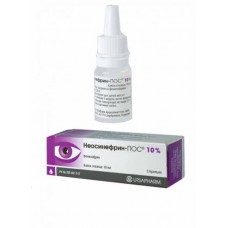Expiration date: 07/2025
Release form
eye drops
Packaging
the bottle is 10 ml.
Pharmacological action
Neosynephrine - alpha-adrenomimetic, vasoconstrictor.
Pharmacodynamics
Phenylephrine is a non-selective ?-agonists, has a pronounced ?-adrenomimetic activity.
When applied topically in ophthalmology causes pupil dilation, improves the outflow of intraocular fluid and constricts blood vessels of the conjunctiva.
Phenylephrine has a pronounced stimulatory effect on the postsynaptic ?-adrenergic receptors, exerts a very weak influence on ?-adrenergic receptors of the heart. The drug has a vasoconstrictor action similar to the action of norepinephrine (noradrenaline), while it is virtually absent chronotropic and inotropic effect on the heart.
Vasopressor effect fenilafrina weaker than that of noradrenaline but is more durable. Causes vasoconstriction in 30 to 90 s after instillation, lasting 2-6 h After instillation phenylephrine reduces the muscle that extends the pupil, smooth muscle of the arterioles of the conjunctiva, thereby causing the pupil to dilate. Mydriasis occurs within 10-60 min after a single instillation and persists for 2 h. Mydriasis caused by fenilafrinom, not accompanied by cycloplegia.
Testimony
- iridocyclitis (prevention of rear adhesions, and reduction of exudation from the iris);
- pupil dilation with ophthalmoscopy and other diagnostic procedures necessary to control the state of the posterior segment of the eye (including postoperative period);
- conduct a provocative test in patients with a narrow profile of the anterior chamber angle and suspected angle-closure glaucoma;
- differential diagnosis superficial and deep injections of the eyeball.
Contraindications
- hypersensitivity to the drug;
- narrow-angle or angle-closure glaucoma;
- arterial hypertension, ischemic heart disease, aortic aneurysm, atrioventricular block I–III degree, arrhythmia;
- tachycardia;
- diabetes mellitus type 1 in history;
- permanent MAO inhibitors, tricyclic antidepressants, antihypertensive drugs;
- additional pupil dilation during surgical operations in patients with impaired integrity of the eyeball, and also in violation of lesoproduktsii;
- hyperthyroidism;
- hepatic porphyria;
- congenital deficit glukozo-6-fosfatdegidrogenaza;
- rhinitis;
- pregnancy;
- the breast-feeding period;
- the age of 12;
- old age.
Caution: patients with diabetes type 2 due to the increased risk povysheniya; due to the fact that phenylephrine causes hypoxia of the conjunctiva of patients with sickle cell anemia, wearing contact lenses, after surgery (reduced healing); cerebral atherosclerosis; long-existing bronchial asthma.
Application of pregnancy and breastfeeding
Use during pregnancy and lactation is contraindicated.
Special instructions
Defense the time of treatment is not recommended to use contact lenses.
Effects on ability to drive vehicles and operate machinery. After treatment, due to changes of accommodation and pupil size, may reduce visual acuity, it is not recommended to drive and engage in activities that require attention, before its restoration.
Composition
1 ml contains:
Active substance: fenilafrina hydrochloride 100 mg
Excipients: benzalkonium chloride (preservative) — 0,05/0,05 mg; disodium edetate — 1/1 mg; water for injections — up to 1 mg
Method of application and doses
The conjunctival.
Adults and children over 12 years of age for pupil dilation in the diagnostic procedures: 1 drop 5% solution once, if necessary (for the maintenance of the mydriasis) it is possible to re instillation after 1 h
With insufficient mydriasis, as well as in patients with a rigid iris for diagnostic mydriasis may use a 10% solution of the same dose.
To carry out diagnostic procedures:
- as a provocative test in patients with a narrow profile of the anterior chamber angle and suspected angle-closure glaucoma is buried 1 drop 5% solution of the drug once. If the difference between the values of intraocular pressure before instillation of the drug and after pupil dilation ranges from 3 to 5 mm Hg. article, the provocative test is considered positive;
- for the differential diagnosis of the type of injection of the eyeball buried 1 drop 5% or 10% solution of the drug once. If 5 minutes after instillation marked narrowing of the vessels of the eyeball, the injection is classified as superficial, while maintaining the redness of the eyes, one should carefully examine the patient for the presence of iridocyclitis or scleritis, because it indicates the extension to the more deeply lying vessels.
When iridotsiklitah to prevent the development and rupture of already formed the rear of adhesions and reduction of exudation in the anterior chamber of the eye 1 drop of 5% or 10% solution of the drug buried in the bag kongungualny patient eye 2-3 times a day for 5-10 days, depending on the severity of the disease.
In the preparation of patients for surgical interventions to achieve mydriasis of a single instillation of 5% or 10% solution 30-60 min before surgery (after opening the envelopes of the eyeball re-instillation of the drug is not allowed).
Side effects
Local
Conjunctivitis, keratitis, periorbital edema, eye pain, burning upon instillation, lacrimation, blurred vision, eye irritation, discomfort in the eye, increased intraocular pressure, blocking the anterior chamber angle (at the narrows), allergic reactions, reactive hyperemia (after drug withdrawal).
Phenylephrine can cause reactive miosis on the day after application. Re-instillation of the drug at this time may give a less pronounced mydriasis than the day before.
Due to a significant reduction of a dilator of the pupil under the influence of fenilafrina, 30-45 minutes after instillation in the anterior chamber of the eye can detect particles of pigment from the pigment leaf of the iris. The slurry in chamber moisture must be differentiated from the manifestations of anterior uveitis or with a hit of blood corpuscles in the anterior chamber.
System: contact dermatitis.
From the CCC: palpitations, increased blood pressure, reflex bradycardia, occlusion of coronary arteries, embolism of pulmonary artery. When using a 10% solution of (older patients with the disease CCC) — ventricular arrhythmias, myocardial infarction.
CNS: headache, vomiting, tremor, insomnia, weakness.
Drug interactions
Mydriatic effect fenilafrina is enhanced when used in combination with local application of atropine. Due to increased vasopressor actions may develop tachycardia.
Application fenilafrina within 21 days after discontinuation of patients, MAO inhibitors and tricyclic antidepressants should be undertaken with caution, since in this case there is an uncontrolled rise in blood pressure.
Vasopressor effect fenilafrina can also potenziruetsa in a joint application with tricyclic antidepressants, ?-blockers, reserpine, guanetidina, metildopoj and m-holinoblokatorami.
Phenylephrine may potentiate the change in cardiovascular activity during inhalation anesthesia as a result of increased sensitivity of the myocardium to adrenergic agonists and the occurrence of ventricular fibrillation.
Use in conjunction with other adrenoceptor agonists can increase the cardiovascular effects fenilafrina.
Application fenilafrina can cause the weakening of concomitant antihypertensive therapy and lead to increased AD, tachycardia.
Pre-instillation of local anesthetics may increase the systemic absorption and prolong mydriasis.
Overdose
Symptoms: anxiety, nervousness, dizziness, sweating, vomiting, tachycardia, weak or shallow breathing.
Treatment: if you have any systemic action fenilafrina to stop undesirable phenomenon by use of ?-adrenoblokiruyuschim funds, such as the introduction of 5 to 10 mg of phentolamine in a/V. If necessary, the injection can be repeated.
Storage conditions
In protected from light place, at temperature not above 25 °C (do not freeze).
Shelf life
2.5 years. After opening the bottle 4 weeks.
Neosinefrin-POS
(Phenylephrine)
10%
10ml
eye
drops
- Brand: Ursapharm

- Availability:
out of stock

